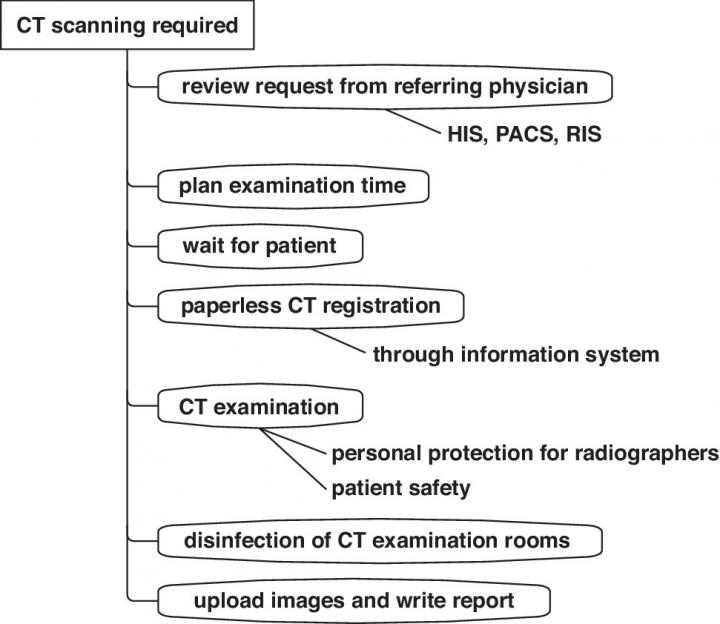Radiologists from Shanghai discuss modifying exam process and disinfecting exam room, while outlining personal protection measures during the coronavirus disease outbreak

Credit: American Journal of Roentgenology (AJR)
Leesburg, VA, May 15, 2020–In an open-access article published ahead-of-print by the American Journal of Roentgenology (AJR), a team of Chinese radiologists discussed modifications to the CT examination process and strict disinfection of examination rooms, while outlining personal protection measures for radiographers during the coronavirus disease (COVID-19) outbreak.
As Jieming Qu, Wenjie Yang, and colleagues at Shanghai Jiao Tong University Medical School Affiliated Ruijin Hospital noted, to undergo CT, patients must exit the fever clinic and proceed to an examination room elsewhere at the institution. Moreover, CT examination rooms are not designed according to the rule of three zones and two aisles–clean zone, semicontaminated zone, contaminated zone; patient aisle and health care worker aisle.
“We were able to urgently install a CT scanner in the fever clinic at the beginning of the outbreak, which allowed rapid screening and early diagnosis,” Qu et al. wrote. A safe infection control strategy for examination of patients with suspected SARS-CoV-2 was also implemented, including reconstructing the area and planning the path a patient would take. Additionally, Qu, Yang, and team rerouted the walking pathway to be one-way, limiting ingress and egress while separating contaminated zones from clean zones.
Qu, Yang, and colleagues’ extensive routine for examination room disinfection included using an air disinfector (maximum volume of 4000 m3/h) and a movable ultraviolet light (intensity higher than 70 μW/cm2 per meter); cleaning nonplastic equipment surfaces, radiation protection items, and doorknobs with a solution at least 75% alcohol; washing plastic surfaces with soapy solution; and mopping the floor with a disinfectant containing 2000 mg Cl per liter of water. Similarly, all patient waste was considered infectious medical waste and managed accordingly.
Typically, CT scanning is performed by two radiographers. As Qu et al. explained: “The operating radiographer works in the locked control room and controls the scanner (contaminated area). The positioning radiographer works inside and outside the scanning room (contaminated area) and is responsible for communicating with and positioning the patient. The positioning radiographer is not allowed to enter into the control room until the shift ends.”
Once a shift is finished, the authors of this AJR article noted that the positioning radiographer is allowed to enter the clean zone only after protective equipment has been properly discarded in the buffer zone.
###
Founded in 1900, the American Roentgen Ray Society (ARRS) is the first and oldest radiological society in North America, dedicated to the advancement of medicine through the profession of radiology and its allied sciences. An international forum for progress in medical imaging since the discovery of the x-ray, ARRS maintains its mission of improving health through a community committed to advancing knowledge and skills with an annual scientific meeting, monthly publication of the peer-reviewed American Journal of Roentgenology (AJR), quarterly issues of InPractice magazine, AJR Live Webinars and Podcasts, topical symposia, print and online educational materials, as well as awarding scholarships via The Roentgen Fund®.
Media Contact
Logan K. Young
[email protected]
Original Source
https:/
Related Journal Article
http://dx.




